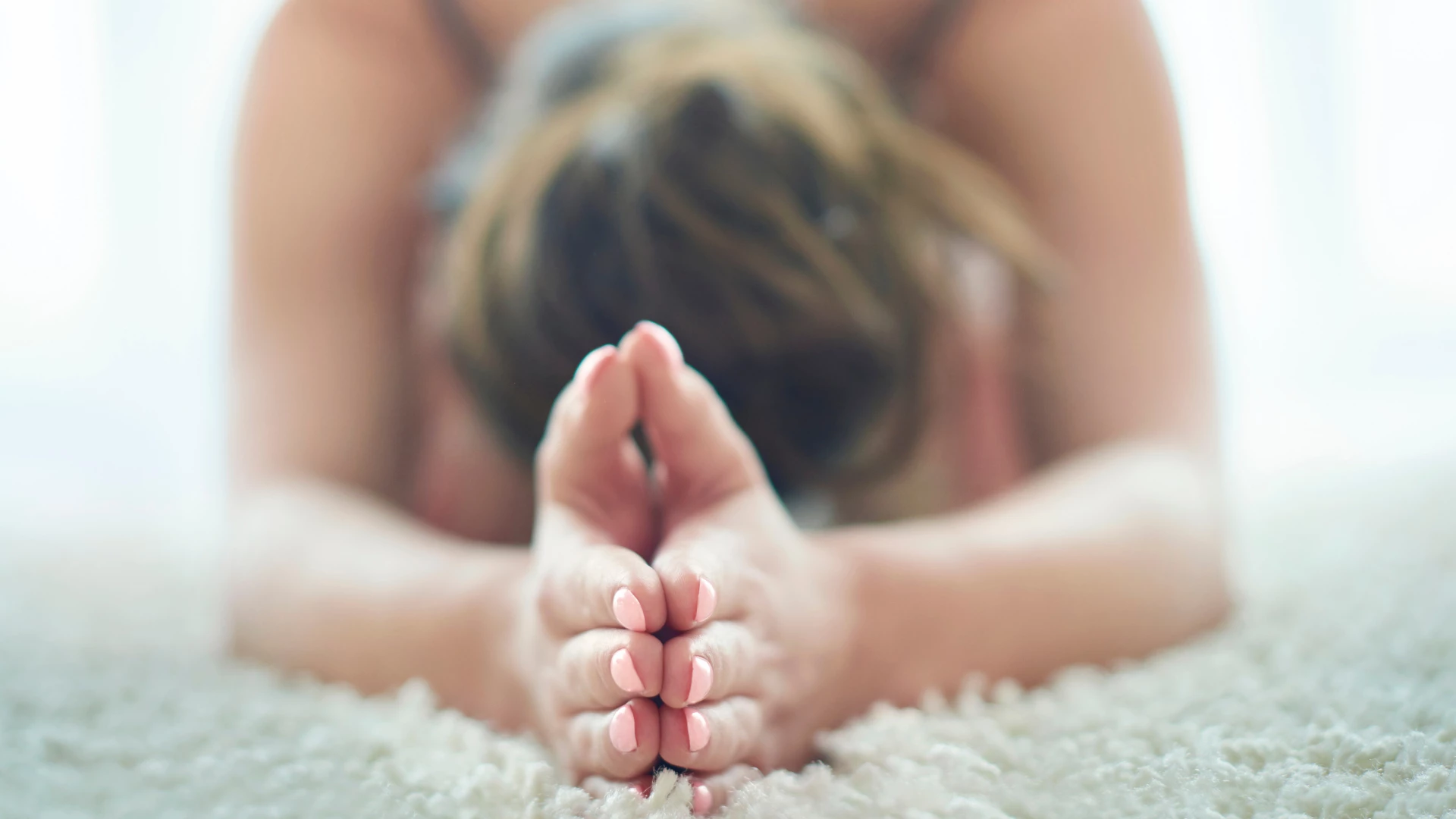4 Foundational Principles of Yin Yoga

Article At A Glance
The primary physical benefit of Yin Yoga is to stimulate the body’s fascia and connective tissues. But what shifts in the mind when we practice passive, long-held yoga postures? In this article, you’ll learn the foundations for a strong and safe Yin Yoga practice that allows you to gently open the heart as you relax the mind.
Yin Yoga is an elegantly simple style of floor-based postural yoga. But Yin Yoga’s simplicity rests upon a foundation of at least four simple-yet-also-sophisticated principles of practice: safety, relaxation, receptivity, and creativity. With the growing popularity and interest in Yin Yoga, revisiting these four foundational principles will hopefully benefit new and seasoned students.
In practice, everything flows from intentions. And the primary intention of Yin Yoga—at least at the physical level—is to gently stimulate the body’s various forms of fascia and connective tissues, encouraging their maintenance, repair, hydration, and vitality.
It is often claimed, incorrectly, that Yin Yoga is the only form of asana that stimulates the fascial fabric of the body. To be sure, any form of physical yoga will “stimulate” the fascia. But it is Yin Yoga’s unique combination of gentle stimulation sustained over several minutes, with the muscles pacified, that delivers what enthusiasts call the “Yin effect,” an experience of deep relaxation, calmness, harmonization, and well-being. In a future blog, I’ll describe these benefits in greater detail. But for now, I would like to share a few reflections on four foundational principles of Yin Yoga so that you can enjoy the benefits of adding some Yin Yoga into your practice.
4 Foundations of Yin Yoga
1. First Foundation of Yin Yoga: Safety

Many Yin teachers describe the first principle of Yin Yoga with the instruction: “Come into an appropriately aligned posture where you feel an appropriate degree of sensation in the target area.” The intention behind this principle is safety, and the key element of safety is discernment. In Yin Yoga, practitioners are guided to discern which area(s) of the body they intend to influence—the so-called “target areas”—as well as which sensations are appropriate and which are inappropriate.
Yin Yoga postures are tools to stimulate the main target areas of the body, including the front thighs, inner thighs, outer hips, backs of legs, and spine. Teachers will recommend entering Yin poses mindfully and slowly so that you can determine which alignment and edge of sensation are most appropriate for you as an individual. A teacher will give you options to try, but ultimately you will determine what alignment and what edge of sensation works best for you.
Generally speaking, sensations in the target area(s) should range from a mild to a moderate sensation of stretch or pressure. Sharp, stabbing, or aggressively painful sensations are never appropriate, and these inappropriate sensations always indicate the need to back off, re-evaluate your alignment and edge, and/or exit the pose entirely.
While exiting a Yin posture, you will likely want to move slowly and mindfully, as your body may feel especially fragile or delicate in the areas addressed by the posture. These sensations are normal, temporary, and to be expected, and they indicate that the tissues received a modest “dose” of exercise. Within thirty seconds to a minute of releasing the posture, these bitter sensations tend to yield to very sweet sensations of relaxation and ease.
In Yin Yoga, by listening carefully and responding wisely to sensations, by skillfully playing your edges, you will nurture self-compassion through a wise relationship with your experience.
2. Second Foundation: Relaxation

The second principle of Yin Yoga is to relax the muscles in the area(s) you intend to target. With the muscles relaxed, the gentle forces of the posture begin to safely stimulate the fascia and connective tissues in and around that specific joint or muscle region. Note: you don’t need to relax every muscle of the body. Rather, you can strategically relax the muscles in the specific target area(s).
More broadly, the principle of relaxation could also apply to the mind. In Yin Yoga, you can relax the mind from its habits of striving, controlling, and grasping. And when you relax on your back for a minute or more after a five-minute Yin hold, you may notice a sublime reduction in the habits of striving, controlling, and grasping. These short Relaxation Poses (Savasana) between Yin postures are an important opportunity to savor the deep relaxation that develops within the practice of Yin Yoga.
3. Third Foundation: Receptivity

The foundations of safety and relaxation set the stage for receptivity to develop. Receptivity is what sustains and transforms the initial relaxation of body and mind into dimensions of stillness over time. Receptivity is what allows the edge of appropriate sensation—the transformative stress—to soak into the tissues for time. Receptivity is the Yin quality of being that Yin Yoga cultivates.
But receptivity is not a rigid rule. The foundation of receptivity doesn’t say, “Thou must be receptive on every and all occasion!” Receptivity, like fluidity, is a characteristic of water. And a refined receptivity will notify you when conditions require moving, adjusting, remaining, or leaving.
While many Yin teachers encourage students to “remain still for time,” I have found that students internalize this as a rule that effectively says, “I’m not allowed to move until the teacher says I can move. I’ll lose all the benefits if I move.” This is a dangerous setup. Remaining robotically still for the sake of stillness overrides the important principle of safely playing one’s edge. For this reason, I prefer to suggest that students “cultivate receptivity toward stillness for a time, but always honor the edge.” In other words, move and adjust when you need to. But otherwise, receptively incline your being toward stillness.
4. Fourth Foundation: Creativity

Practicing the first three foundations of Yin Yoga—safety, relaxation, and receptivity—requires a fourth foundation: yogic creativity. The wise action to be taken cannot be instructed by a teacher. Rather, wise action must be creatively discovered by the student.
A good Yin teacher will help guide their students to find their own optimal alignments and individual ways of embodying the practice. And by creatively playing with different alignments, different usages of props, different ranges of motion, different degrees of relaxation, different times for holds, different breath, and meditation practices, the Yin yogi becomes more intimately attuned to the nature of their physical, energetic and psycho-emotional experience.
For this reason, I sometimes describe Yin Yoga as a wonderfully creative vehicle for cultivating embodied wisdom and compassion. The more wisely we understand the nature of our experience, the more compassionately we can respond to that experience.
I hope this brief overview of the Four Foundations of Yin Yoga will support your practice or teaching.
Also, read...
A Yin Yoga Home Practice
A Grounding Yin/Restorative Sequence: Yoga for Spring Renewal
A Yin Yoga Sequence to Connect You to the Present Moment
Related courses

Josh Summers, acupuncturist, Yin Yoga teacher, and lifelong meditator, shares a passion for the principles of Chinese Medicine, Buddhist meditation, Yin Yoga, and holistic healing. Josh lives in rural Maine with his partner, Terry Cockburn, where they co-lead the River Bird Sangha – an online practice community for Yin Yoga, Qi Gong, and meditation. For a FREE copy of Josh’s ebook The What, Why, and How of Yin Yoga, the podcast Everyday Sublime, or their Yin Yoga School and practice sangha, please visit Josh at www.joshsummers.net.



